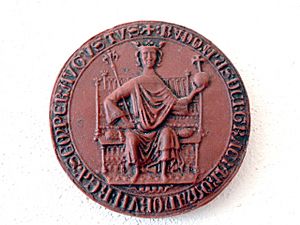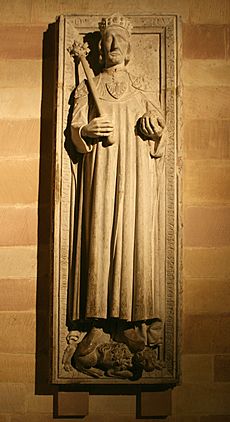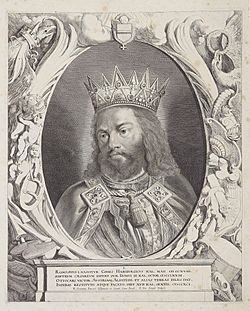Rudolf I of Germany facts for kids
Quick facts for kids Rudolf I |
|
|---|---|

Seal of Rudolf I inscribed: RUDOLFUS DEI GRACIA ROMANORUM REX SEMPER AUGUSTUS ("Rudolf by the grace of God King of the Romans, ever majestic")
|
|
| King of Germany | |
| Reign | 1 October 1273 – 15 July 1291 |
| Coronation | 24 October 1273 Aachen Cathedral |
| Predecessor | (Richard of Cornwall) Interregnum |
| Successor | Adolf of Nassau |
| Born | 1 May 1218 Limburgh Castle near Sasbach am Kaiserstuhl |
| Died | 15 July 1291 (aged 73) Speyer |
| Burial | Speyer Cathedral |
| Spouse |
|
| Issue more... |
|
| House | Habsburg |
| Father | Albert IV, Count of Habsburg |
| Mother | Hedwig of Kyburg |
Rudolf I (born May 1, 1218 – died July 15, 1291) was the first King of Germany from the House of Habsburg. He ruled from 1273 until his death. Rudolf's election as king ended a long period without a ruler, known as the Great Interregnum. This period began after the death of Emperor Frederick II in 1250.
Rudolf was originally a count from the Swabian region. He was the first Habsburg ruler to gain control of the important areas of Austria and Styria. He won these lands from his powerful rival, King Ottokar II of Bohemia, in the Battle on the Marchfeld in 1278. Austria and Styria remained under Habsburg rule for over 600 years. These lands became the heart of the Habsburg monarchy and are now part of modern-day Austria. Rudolf played a key role in making the Habsburg family a very important ruling family in Europe.
Contents
Rudolf's Early Life
Rudolf was born on May 1, 1218, at Limburgh Castle. This castle was located near Sasbach am Kaiserstuhl in what is now southwestern Germany. His father was Count Albert IV of Habsburg. His mother was Hedwig, the daughter of Count Ulrich of Kyburg. Around 1232, Rudolf began training as a knight. He served as a squire to his uncle, Rudolf I, Count of Laufenburg.
Becoming the Count of Habsburg
When his father died in 1239, Rudolf inherited large lands. These lands were around the family's main castle, Habsburg Castle, in modern-day Switzerland. He also inherited lands in Alsace. In 1240, Emperor Frederick II tried to limit Rudolf's growing power. The Emperor gave the region of Schwyz special freedom. This move also aimed to control the important "Devil's Bridge" in the Schöllenenschlucht valley.
In 1242, a man named Hugh of Tuffenstein insulted Count Rudolf. Rudolf then attacked Hugh's lands but could not capture his main castle. Later that day, Rudolf secretly paid the guards to let him into the city. He then killed Hugh. In 1244, Rudolf built Neuhabsburg Castle near Lake Lucerne. This helped him control the lake and the nearby forest communities of Uri, Schwyz, and Unterwalden.
In 1245, Rudolf married Gertrude, the daughter of Count Burkhard III of Hohenberg. As her wedding gift, he received castles and lands in Alsace. This made him a powerful noble in Swabia. That same year, Pope Innocent IV removed Emperor Frederick II from the church. Rudolf chose to support the Pope. The forest communities, however, sided with the Emperor. This gave them a reason to attack Neuhabsburg Castle. Rudolf successfully defended it. By supporting the Pope, Rudolf gained more power and influence.
Rudolf often visited the court of his godfather, Emperor Frederick II. He was very loyal to Frederick and his son, King Conrad IV of Germany. Because of his loyalty, Rudolf received many land grants. In 1254, he joined other nobles against Bertold II, Bishop of Basle. He attacked parts of Basle and burned down a nunnery. For this, Pope Innocent IV removed Rudolf and his allies from the church. As a way to make up for this, Rudolf joined King Ottokar II of Bohemia in the Prussian Crusade of 1254. While there, he helped found the city of Königsberg, which was named after King Ottokar.
How Rudolf Became King
The time after the fall of the Hohenstaufen family was very chaotic in Germany. This period, known as the interregnum, allowed Count Rudolf to expand his lands. His wife, Gertrude, was an heiress from the Hohenberg family. When his uncle, Count Hartmann IV of Kyburg, died without children in 1264, Rudolf took control of Hartmann's valuable estates. He also won conflicts against the Bishops of Strasbourg and Basel. These victories increased his wealth and good name. He also bought rights to various lands from religious leaders.
All these new lands and influence made Rudolf the most powerful noble in southwestern Germany. In this area, the old Duchy of Swabia had broken apart. This allowed its smaller rulers to become fully independent. In the autumn of 1273, the important prince-electors met to choose a new king. This happened after Richard of Cornwall died in England in April 1272. Rudolf was elected king in Frankfurt on October 1, 1273. He was 55 years old at the time. His election was largely due to the efforts of his brother-in-law, Frederick III of Nuremberg. Rudolf also gained the support of Duke Albert II of Saxony and Elector Palatine Louis II. He did this by promising to marry two of his daughters to them.
Because of this, King Ottokar II of Bohemia was almost alone in opposing Rudolf. Ottokar was also a candidate for the throne. Other candidates included Prince Siegfried I of Anhalt and Margrave Frederick I of Meissen. By allowing Duke Henry XIII of Lower Bavaria to vote instead of the King of Bohemia, Rudolf received all seven votes.
Rudolf Becomes King of the Germans
Rudolf was crowned in Aachen Cathedral on October 24, 1273. To gain the Pope's approval, Rudolf gave up all imperial claims in Rome, the Pope's lands, and Sicily. He also promised to lead a new crusade and took a special vow in 1275. Pope Gregory X recognized Rudolf as king. He also convinced King Alfonso X of Castile to do the same. Alfonso had been chosen as a rival German king in 1257. This meant Rudolf had now surpassed the two heirs of the Hohenstaufen family, whom he had once served.
In November 1274, the Imperial Diet (a big meeting of rulers) in Nuremberg made an important decision. They said that all royal lands taken since Emperor Frederick II's death must be returned. They also demanded that King Ottokar II explain why he had not recognized the new king. Ottokar refused to appear or return the lands of Austria, Styria, Carinthia, and March of Carniola. He had claimed these lands through his first wife. Rudolf refused to accept Ottokar's claim to these lands. He stated that they should return to the royal crown because there were no male heirs. King Ottokar was then placed under an imperial ban, which meant he lost his rights and protection. In June 1276, war was declared against him.
Rudolf convinced Duke Henry XIII of Lower Bavaria, who was Ottokar's ally, to switch sides. This forced the Bohemian king to give up the four provinces to royal control in November 1276. Rudolf then gave Ottokar back the Kingdom of Bohemia. He also arranged for one of his daughters to marry Ottokar's son, Wenceslaus II. Rudolf then made a grand entry into Vienna. However, Ottokar later questioned the agreement. He gained support from several German princes, including Henry XIII of Lower Bavaria again. To fight this group, Rudolf formed an alliance with King Ladislaus IV of Hungary. He also gave more special rights to the citizens of Vienna. On August 26, 1278, the armies met at the Battle on the Marchfeld. Ottokar was defeated and killed. The Margraviate of Moravia was taken over, and Rudolf's representatives governed it. Ottokar's widow, Kunigunda of Slavonia, only controlled the area around Prague. The young Wenceslaus II was again promised to Rudolf's youngest daughter, Judith.
Rudolf then focused on the lands in Austria and nearby areas. These lands became part of the royal domain. He spent several years making sure his power was strong there. It was difficult to make sure his family would rule these provinces after him. But eventually, the other princes agreed. In December 1282, at a big meeting in Augsburg, Rudolf gave his sons, Albert and Rudolf II, the duchies of Austria and Styria. This was how he started the powerful House of Habsburg. He also made the twelve-year-old Rudolf the Duke of Swabia. This was just a title, as the duchy had no real ruler since Conradin was executed. The 27-year-old Duke Albert was married to a daughter of Count Meinhard II of Gorizia-Tyrol. Albert was strong enough to have influence in these new family lands.
In 1286, King Rudolf officially gave Albert's father-in-law, Count Meinhard, the Duchy of Carinthia. This was one of the lands taken from Ottokar. The other princes of the Empire did not want Rudolf to give all the recovered royal lands to his own sons. His allies also needed their rewards. Moving to the west, in 1281, Rudolf forced Count Philip I of Savoy to give him some land. Then he made the citizens of Bern pay taxes they had refused. In 1289, he marched against Count Philip's successor, Otto IV. He forced Otto to show his loyalty.
In 1281, Rudolf's first wife died. On February 5, 1284, he married Isabella. She was the daughter of Duke Hugh IV of Burgundy.
Rudolf was not very successful in bringing lasting peace within the empire. He did issue orders for peace in Bavaria, Franconia, and Swabia. At a meeting in Würzburg in March 1287, he called for peace across the whole Empire. But the king did not have enough power, money, or determination to make sure these rules were followed. However, in December 1289, he led an attack into Thuringia. There, he destroyed many castles belonging to rebellious nobles. In 1291, he tried to get his son Albert elected as the next German king. The electors refused. They said they could not support two kings. But in reality, they were likely worried about the Habsburg family becoming too powerful. After Rudolf's death, they elected Count Adolf of Nassau instead.
Rules Affecting Jewish Communities
In 1286, Rudolf I introduced new rules for Jewish communities. He declared them servi camerae, meaning "serfs of the treasury." This change took away some of their political freedoms. Many Jewish people, including Rabbi Meir of Rothenburg, decided to leave Germany. Rabbi Meir, who was a very important religious leader, was captured in Lombardy and put in prison in Alsace. It is said that a large sum of money was raised to free him. However, Rabbi Meir refused the ransom. He feared that paying it would encourage others to imprison rabbis. He died in prison after seven years. Fourteen years after his death, a ransom was paid for his body. Alexander ben Shlomo (Susskind) Wimpfen paid it, and Rabbi Meir was then buried next to him.
Death of Rudolf I

Rudolf died in Speyer on July 15, 1291. He was buried in Speyer Cathedral. Only one of his sons, Albert I, outlived him. Most of his daughters lived longer than him, except for Catherine, who died in 1282 during childbirth, and Hedwig, who died in 1285 or 1286.
Rudolf's reign is most remembered for making the House of Habsburg a very strong ruling family. They became powerful in the southeastern part of the empire. In other areas, the power of the Emperor continued to decline, as it had for centuries. The local princes were mostly left to rule their own lands.
In the famous poem Divine Comedy, Dante shows Rudolf sitting outside the gates of purgatory. Dante describes him as someone "who neglected that which he ought to have done."
Rudolf's Family and Children
Rudolf was married two times. His first marriage was in 1251 to Gertrude of Hohenberg. His second marriage was in 1284 to Isabelle of Burgundy. All of his children were from his first marriage.
- Matilda (born around 1253, Rheinfelden – died December 23, 1304, Munich). She married Duke Louis II of Bavaria in 1273 in Aachen. She became the mother of Duke Rudolf I of Bavaria and Emperor Louis IV.
- Albert I of Germany (born July 1255 – died May 1, 1308). He became the Duke of Austria and also of Styria.
- Catherine (born 1256 – died April 4, 1282, Landshut). She married Duke Otto III of Bavaria in 1279 in Vienna.
- Agnes [Gertrude] (born around 1257 – died October 11, 1322, Wittenberg). She married Duke Albert II of Saxony in 1273. She became the mother of Duke Rudolf I of Saxe-Wittenberg.
- Hedwig (born around 1259 – died January 26, 1285 or October 27, 1286). She married Margrave Otto VI of Brandenburg-Salzwedel in 1270 in Vienna. They had no children.
- Clementia (born around 1262 – died after February 7, 1293). She married Charles Martel of Anjou in 1281 in Vienna. Charles Martel claimed the throne of Hungary.
- Hartmann (born 1263, Rheinfelden – died December 21, 1281). He drowned in Rheinau.
- Rudolf II, Duke of Austria and Styria (born 1270 – died May 10, 1290, Prague). He held the title of Duke of Swabia. He was the father of John the Parricide of Austria.
- Judith (born March 13, 1271 – died June 18, 1297, Prague). She married King Wenceslaus II of Bohemia on January 24, 1285. She became the mother of King Wenceslaus III of Bohemia, Poland, and Hungary.
- Samson (born before October 19, 1275 – died young).
- Charles (born February 14, 1276 – died August 16, 1276).
Images for kids
-
Rudolf's cenotaph in Speyer Cathedral
See also
 In Spanish: Rodolfo I de Habsburgo para niños
In Spanish: Rodolfo I de Habsburgo para niños
- Kings of Germany family tree



